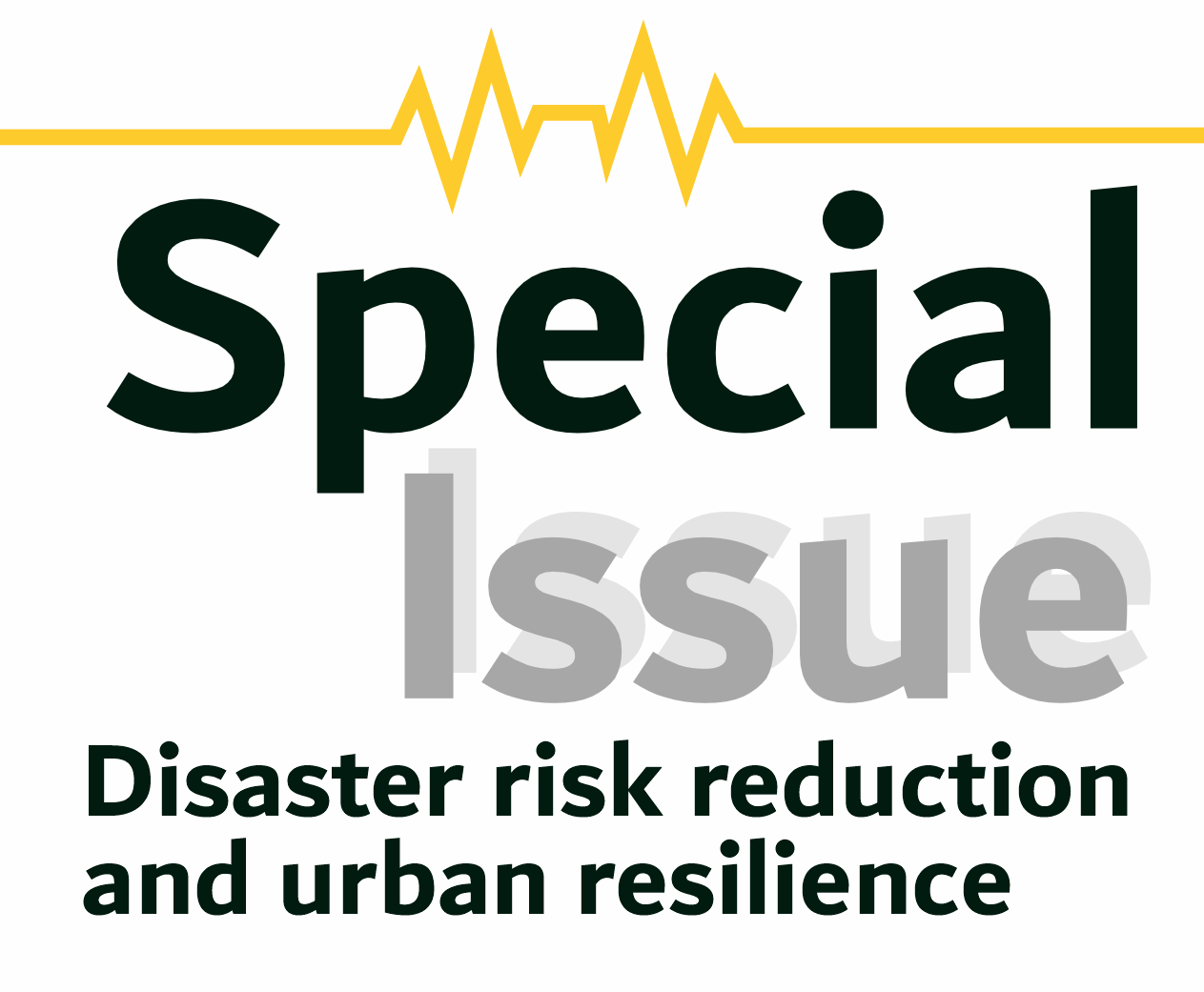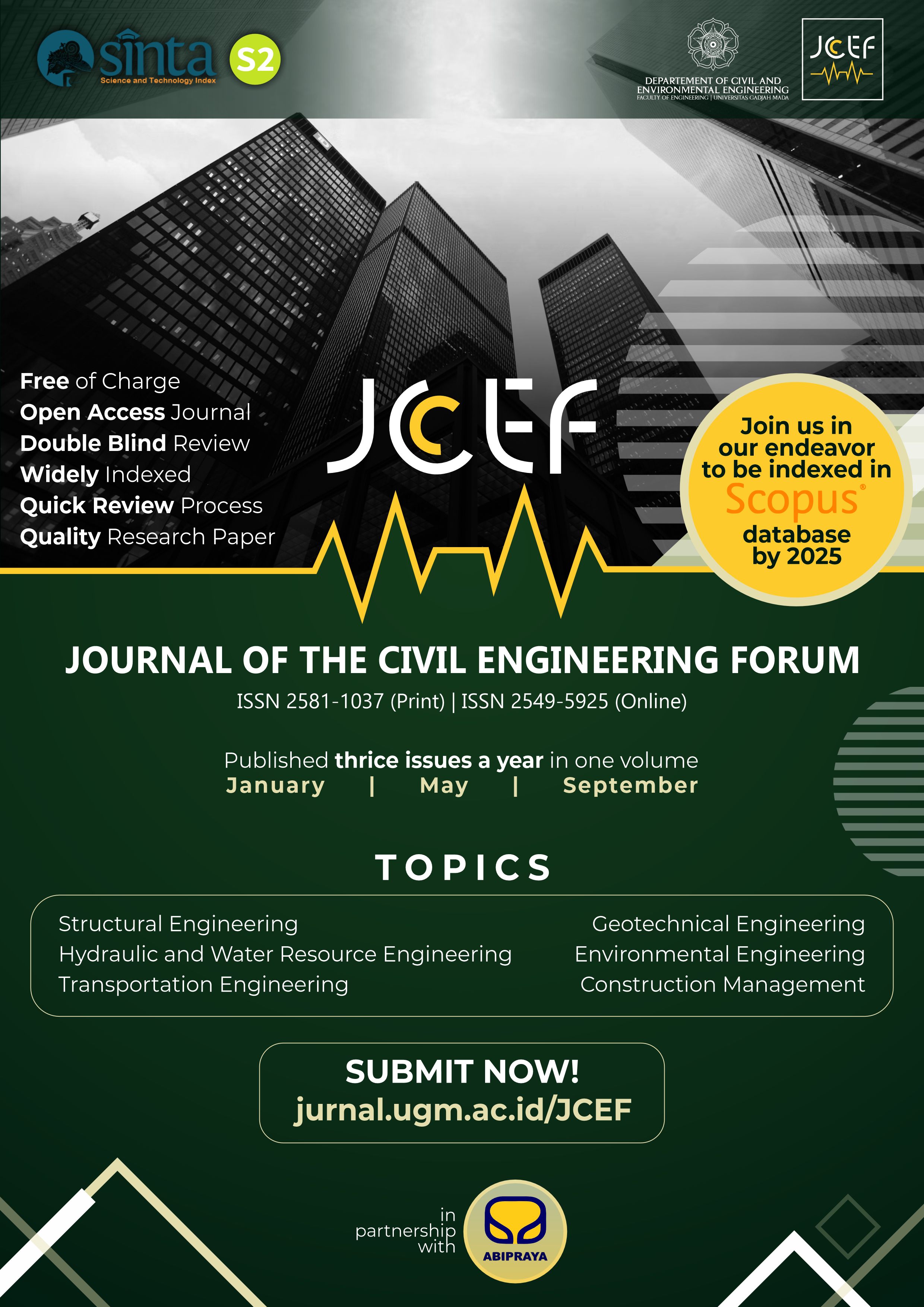The Advantages and Disadvantages of Palm Oil Empty Fruit Bunch on Bricks and Mortar
Abstract
Palm oil has a great commercial value in the global vegetable oil market, due to having several beneficial uniqueness such as significant profits and high yields for farmers, as well as effective and efficient land use. As the second-largest producer of palm oil in the world, Malaysia produces an enormous amount of empty fruit bunch (EFB) as biomass waste, whose proper and improper disposal incurs costs and environmental problems, respectively. This EFB fibre is also used to produce bricks and mortar for building construction, due to being a sustainable solution to environmental problems. Therefore, this study aims to analyze the existing literature related to the application of EFB in the civil engineering field. This focused on the properties of the fibre and its effects on bricks and mortar, to gauge the challenges and prospects of EFB products in the local industry. EFB fibre is a porous voluminous cellulose structure, whose properties vary among each other due to diverse origins, species, and biological growth conditions. This is useful in reducing the weight and thermal conductivity of bricks, as well as slightly increasing their tensile and flexural strengths. However, some disadvantages were observed for the EFB bricks, with the workability and compressive strength being lower. The water absorption of this product was also higher than normal bricks. This confirmed that EFB fibre should be minimally used in bricks and mortar. As a natural fibre, concerns are often observed on inconsistent quality, poor fire resistance, and decay risk, which need to be solved before the use of bricks in the construction industry. This study recommends several patterns of improving the strength, quality, and consistency of EFB bricks, such as the alkaline treatment, which roughens the surface area of the product to enhance the fibre- atrix adhesion.
References
Abas, R., Kamarudin, M. F., Nordin, A. B. A. and Simeh, M. A. (2011), ‘A study on the Malaysian oil palm biomass sector—supply and perception of palm oil millers’, Oil Palm Industry Economic Journal 11(1), 28–41.
Abdul Kadir, A. A., Sarani, N. A., Mokhtar, S. Z. and Abdullah, M. M. A. B. (2017), Physical and mechanical properties by utilizing empty fruit bunch into fired clay brick, in ‘AIP Conference Proceedings’, Vol. 1835, AIP Publishing LLC, p. 020012.
Ahmad, F. B., Zhang, Z., Doherty, W. O. and O’Hara, I. M. (2019), ‘The outlook of the production of advanced fuels and chemicals from integrated oil palm biomass biorefinery’, Renewable and Sustainable Energy Reviews 109, 386–411.
Alam, A., Er, A. and Begum, H. (2015), ‘Malaysian oil palm industry: Prospect and problem’, Journal of Food, Agriculture & Environment 13(2), 143–148.
Awalludin, M. F., Sulaiman, O., Hashim, R. and Nadhari, W. N. A. W. (2015), ‘An overview of the oil palm industry in malaysia and its waste utilization through thermochemical conversion, specifically via liquefaction’, Renewable and Sustainable Energy Reviews 50, 1469–1484.
Aziz, F. N. A. A., Bida, S. M., Nasir, N. A. M. and Jaafar, M. S. (2014), ‘Mechanical properties of lightweight mortar modified with oil palm fruit fibre and tire crumb’, Construction and Building Materials 73, 544–550.
Babinszki, B., Jakab, E., Terjék, V., Sebestyén, Z., Várhegyi, G., May, Z., Mahakhant, A., Attanatho, L., Suemanotham, A., Thanmongkhon, Y. et al. (2021), ‘Thermal decomposition of biomass wastes derived from palm oil production’, Journal of Analytical and Applied Pyrolysis 155, 105069.
Baharuddin, A. S., Yunos, N. S. H. M., Mahmud, N. A. N., Zakaria, R. and Yunos, K. F. M. (2012), ‘Effect of high-pressure steam treatment on enzymatic saccharification of oil palm empty fruit bunches’, BioResources 7(3), 3525–3538.
Chang, S. H. (2014), ‘An overview of empty fruit bunch from oil palm as feedstock for bio-oil production’, biomass and bioenergy 62, 174–181.
Council of Palm Oil Producing Countries (2020), Technical report, Palm oil supply and demand outlook report 2020.
Dalimin, M. N. (1995), ‘Renewable energy update: Malaysia’, Renewable energy 6(4), 435–439.
Danso, H., Martinson, D. B., Ali, M. and Williams, J. B. (2015), ‘Physical, mechanical and durability properties of soil building blocks reinforced with natural fibres’, Construction and Building Materials 101, 797–809.
Ghavami, K., Toledo Filho, R. D. and Barbosa, N. P. (1999), ‘Behaviour of composite soil reinforced with natural fibres’, Cement and Concrete Composites 21(1), 39–48.
Idris, J., Shirai, Y., Anduo, Y., Ali, A. A. M., Othman, M. R., Ibrahim, I., Husen, R. and Hassan, M. A. (2015), ‘Improved yield and higher heating value of biochar from oil palm biomass at low retention time under self-sustained carbonization’, Journal of Cleaner Production 104, 475–479.
Index Mundi (2022), ‘Palm Oil Production by Country in 1000 MT’, Accessed Jan. 5, 2022 [Online]. URL: https://www.indexmundi.com/agriculture/?commodity=palm-oilgraph=production
Ismail, S. and Yaacob, Z. (2011), ‘Properties of laterite brick reinforced with oil palm empty fruit bunch fibres’, Pertanika Journal of Science and Technology 19(1), 33–43.
Kadir, A., Sarani, N., Zaman, N. and Abdullah, M. M. A. B. (2017), Feasibility study on utilization of palm fibre waste into fired clay brick, in ‘AIP Conference Proceedings’, Vol. 1835, AIP Publishing LLC, p. 020039.
Karina, M., Onggo, H., Abdullah, A. D., Syampurwadi, A. et al. (2008), ‘Effect of oil palm empty fruit bunch fiber on the physical and mechanical properties of fiber glass reinforced polyester resin’, Journal of Biological Sciences 8(1), 101–106.
Kolop, R., Haziman, W. and Eng, J. (2008), Properties of cement blocks containing high content of oil palm empty fruit bunches (efb) fibers, in ‘International Conference on Civil Engineering 2008’.
Kong, S.-H., Loh, S.-K., Bachmann, R. T., Rahim, S. A. and Salimon, J. (2014), ‘Biochar from oil palm biomass: A review of its potential and challenges’, Renewable and sustainable energy reviews 39, 729– 739.
Ling, J. H., Lim, Y. T., Leong, W. K., Jusli, E. and Sia, H. T. (2019), Properties of cement brick with partial replacement of sand and cement with oil palm empty fruit bunches and silica fume, in ‘Journal of the Civil Engineering Forum’, Vol. 5, pp. 289–300.
Ling, J. H., Lim, Y. T., Leong, W. K. and Sia, H. T. (2021a), ‘Effects of adding silica fume and empty fruit bunch to the mix of cement brick’, Indonesian Journal of Computing, Engineering and Design (IJoCED) 3(1), 19–30.
Ling, J. H., Lim, Y. T., Leong, W. K. and Sia, H. T. (2021b), ‘Utilization of oil palm empty fruit bunch in cement bricks’, JACEE (Journal of Advanced Civil and Environmental Engineering) 4(1), 1–10.
Mahjoub, R., Bin Mohamad Yatim, J. and Mohd Sam, A. R. (2013), ‘A review of structural performance of oil palm empty fruit bunch fiber in polymer composites’, Advances in Materials Science and Engineering 2013.
Malaysian Palm Oil Board (2020), ‘ Economic Industry Development Division’, Accessed Oct. 3, 2020 [Online].
URL: http://bepi.mpob.gov.my/index.php/en/statistics/area.html
Mulyantara, L. T., Rizaluddin, A. T., Nakagawaizumi, A., Ohi, H., Nakamata, K. et al. (2015), ‘Properties of fibers prepared from oil palm empty fruit bunch for use as corrugating medium and fiberboard’, Japan Tappi Journal 69(12), 1349– 1359.
Nambiappan, B., Ismail, A., Hashim, N., Ismail, N., Shahari, D. N., Idris, N. A. N., Omar, N., Salleh, K. M., Hassan, N. A. M. and Kushairi, A. (2018), ‘Malaysia: 100 years of resilient palm oil economic performance’, Journal of Oil Palm Research 30(1), 13–25.
Olaoye, R., Oluremi, J. and Ajamu, S. (2013), ‘The use of fibre waste as complement in concrete for a
sustainable environment’, Innovative Systems Design and Engineering 4(9), 91–97.
Omar, R., Idris, A., Yunus, R., Khalid, K. and Isma, M. A. (2011), ‘Characterization of empty
fruit bunch for microwave-assisted pyrolysis’, Fuel 90(4), 1536–1544.
Rama Rao, P. and Ramakrishna, G. (2020), Experimental investigation mechanical properties of oil palm empty fruit bunch fiber reinforced cement mortar, in ‘Materials Today :Proceeding’.
Ramli, M. B. and Alonge, O. R. (2016), ‘Characterization of metakaolin and study on early age mechanical strength of hybrid cementitious composites’, Construction and Building Materials 121, 599– 611.
Raut, A. N. and Gomez, C. P. (2016), ‘Thermal and mechanical performance of oil palm fiber reinforced
mortar utilizing palm oil fly ash as a complementary binder’, Construction and Building Materials 126, 476–483.
Raut, A. N. and Gomez, C. P. (2017), ‘Development of thermally efficient fibre-based eco-friendly brick reusing locally available waste materials’, Construction and Building Materials 133, 275–284.
Research and Markets (2020), ‘ Palm Oil Market: Global Industry Trends, Share, Size, Growth,
Opportunity and Forecast 2019-2024’, Accessed Dec. 4, 2020 [Online].
URL: https://www.researchandmarkets.com/research/pwv8pc/globalstudyon?w = 4 : Researchand Markets
Saba, N., Paridah, M., Abdan, K. and Ibrahim, N. (2016), ‘Effect of oil palm nano filler on mechanical and morphological properties of kenaf reinforced epoxy composites’, Construction and building materials 123, 15– 26.
Salim, N., Hashim, R., Sulaiman, O., Ibrahim, M., Sato, M. and Hiziroglu, S. (2012), ‘Optimum manufacturing parameters for compressed lumber from oil palm (elaeis guineensis) trunks: Respond surface approach’, Composites Part B: Engineering 43(3), 988–996.
Shahriarinour, M., Wahab, M. N. A., Ariff, A. B., Mustafa, S. and Mohamad, R. (2011), ‘Effect of various pretreatments of oil palm empty fruit bunch fibres for subsequent use as substrate on the performance of cellulase production by aspergillus terreus’, BioResources 6(1), 291–307.
Singh, P., Sulaiman, O., Hashim, R., Peng, L. C. and Singh, R. P. (2013), ‘Using biomass residues from oil palm industry as a raw material for pulp and paper industry: potential benefits and threat to the environment’, Environment, development and sustainability 15(2), 367–383.
Sudiyani, Y., Styarini, D., Triwahyuni, E., Sembiring, K. C., Aristiawan, Y., Abimanyu, H., Han, M. H. et al. (2013), ‘Utilization of biomass waste empty fruit bunch fiber of palm oil for bioethanol production using pilot–scale unit’, Energy Procedia 32, 31–38.
Sulaiman, F., Abdullah, N., Gerhauser, H. and Shariff, A. (2011), ‘An outlook of malaysian energy, oil palm industry and its utilization of wastes as useful resources’, Biomass and bioenergy 35(9), 3775–3786.
Sun, R., Tomkinson, J. and Bolton, J. (1999), ‘Effects of precipitation ph on the physico-chemical properties of the lignins isolated from the black liquor of oil palm empty fruit bunch fibre pulping’, Polymer degradation and stability 63(2), 195–200.
Sung, C. T. B., Joo, G. K. and Kamarudin, K. N. (2010), ‘Physical changes to oil palm empty fruit bunches (efb) and efb mat (ecomat) during their decomposition in the field’, Pertanika J. Trop. Agric. Sci 33(1), 39–44.
Umikalsom, M. S., Ariff, A., Zulkifli, H., Tong, C., Hassan, M. and MIA, K. (1997), ‘The treatment of oil palm empty fruit bunch fibre for subsequent use as substrate for cellulase production by chaetomium globosum kunze’, Bioresource Technology 62, 1–9.
Virk, A. S., Hall, W. and Summerscales, J. (2010), ‘Failure strain as the key design criterion for fracture
of natural fibre composites’, Composites Science and Technology 70(6), 995–999.
Vishnu Vardhini, K., Murugan, R., Selvi, C. and Surjit, R. (2016), ‘Optimisation of alkali treatment of banana fibres on lignin removal’. Yusoff, S. (2006), ‘Renewable energy from palm oil–innovation on effective utilization of waste’, Journal of cleaner production 14(1), 87–93.
Copyright (c) 2022 The Author(s)

This work is licensed under a Creative Commons Attribution-ShareAlike 4.0 International License.
Copyright is granted to authors for the purpose of providing protection for articles written to describe experiments and their results. JCEF will protect and defend the work and reputation of the author and are also willing to address any allegations of violation, plagiarism, fraud, etc. against articles written and published by JCEF. JCEF is published under the terms of the Creative Commons Attribution-ShareAlike 4.0 International License (CC BY-SA 4.0). The author holds the copyright and assigns the journal rights to the first publication (online and print) of the work simultaneously.





